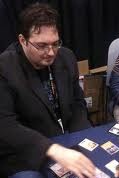 As I walked in the room Brandon Sanderson said, “Have her sit by me. I’m going to help her a little bit.”
As I walked in the room Brandon Sanderson said, “Have her sit by me. I’m going to help her a little bit.”
He spent approximately fifteen minutes with me, and he helped me a lot. Fourteen minutes of that was reminding me how to play Magic the Gathering and whipping me in a match. The other minute stretched me to my next writing plateau.
I knew I needed to improve my writing, but I also knew that the resources available to me weren’t going to cut it anymore. I needed something to yank me upwards or my pace would be so slow that I wouldn’t see anything published for years to come. I knew this, but I didn’t know where to turn next. I’d been listening to Writing Excuses (a podcast for writers done by Brandon Sanderson, Dan Wells, and Howard Taylor–Mary Robinette Kowal came later) for quite a while, so when they talked about Conduit, I decided to make the trip, stay with family nearby so I could afford it, and see what I could learn. I didn’t expect to end up in a MTG game (Magic the Gathering) with Brandon Sanderson, but when my son pointed out the sign-up to me, I blew the dust off my cards and showed up. In my efforts to observe a game between Brandon and his fans, he noticed me enough and talked with me enough to recognize my nervousness about the upcoming tournament.
So, he sat by me, coached me in what types of cards to pick and how to put my deck together. When my turn to play against him came, I worked up my courage to talk about writing.
“I’ve been listening to Writing Excuses,” I said. “And it has helped me a lot.”
As his creatures attacked mine and I tried to block, I told him a short version of the story about how I started writing. (If you haven’t read the story, you can go to my webpage, www.coletteblack.net, and visit the About Me page.)
Then I asked. “I’ve been writing for a while, I’m getting better, but I can tell I still need to improve a lot, but I don’t know what else to do. Can you give me any suggestions?”
He looked at me a moment, perhaps gauging my sincerity, and then said. “David Farland still does workshops. He’s a good writing teacher and I suggest you attend one.”
And then he killed me, or my cards I should say, and I went to the next match and got royally scobbed again. I should point out, if it hadn’t been for his help I would have never lasted three rounds in any of the matches that night. I didn’t do great, but I held my own.
I signed up for the next David Farland workshop I could fit into my schedule–the Professional Writers Workshop. I thought it would be beyond my amateur skills, but he made the class work for everyone, regardless of our skill level. And my writing ability jumped dramatically. It wasn’t only the teaching. It was also having a group of serious writers, the kind who are willing to spend money to get better, surrounding me and giving me critiques. Between David’s well-done workshop, and my fellow writers amazing skills, each time I’ve attended a workshop my writing ability has improved not by the gradual climb of Butt in Chair Fingers on Keyboard–though that is important–but by a step or two upward.
So, in my opinion, if you find yourself on a writing plateau, then find yourself a good workshop with personal instruction and serious writers who will take the time to critique 10-20 pages of your work and really give it a serious once-over. If you’re willing to learn, you’ll jump to the next level. Eventually you’ll reach a point where you might need something more, but so far, it’s worked well for me. I’ve attended three workshops so far, and if I could scrape together the money right now, I’d be attending his next one. I’ll probably try Dean Wesley Smith’s online workshop next. When will I be so good I won’t need them? Probably never. I can’t imagine ever reaching a plateau that is so high that I can’t stretch and reach another one.
I also recommend conventions, conferences, good critique groups, seminars, and books, but nothing beats the type of instruction you can get in a workshop. Butt in chair is vital, but listening to the men and women who already know what they’re doing can make the time in the chair really count.




